- Pentalobe screwdriver
- Phillips screwdriver
- Metal spatula
- Plastic spatula
- Suction cup
Preface
Use the following picture guide to easily change the display on your iPhone & and iPhone & Plus. Make sure that you install the home button from your old display into the new one. Without your original home button, the fingerprint sensor with touch ID will not work.
You should make a backup of your iPhone before changing the display and then turn it off.
Step 1: Remove Pentalobe screws
Step 2: Open display
Attach a suction cup to the lower half of the display assembly, just above the home button.
Be sure the suction cup does not overlap with the home button, as this will prevent a seal from forming between the suction cup and front glass.
Step 3: Detach display from frame

Pull up on the suction cup to create a small gap between the display assembly and the rear case.
Insert the flat end of a spudger into the gap.
The watertight adhesive holding the display in place is very strong, and creating this initial gap takes a significant amount of force. If you're having a hard time opening a gap, rock the screen up and down to weaken the adhesive until you can fit a spudger inside.
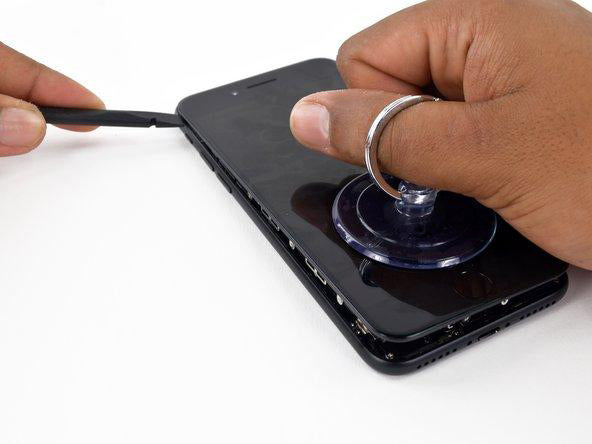
Slide the spudger up the left side of the iPhone, starting at the lower edge and moving towards the volume control buttons and silent switch.
Do not pry along the top edge of the phone, you risk damaging the plastic clips securing the display.

Insert the flat edge of a spudger into the bottom right corner of the device.
Twist the spudger to widen the gap between the display assembly and the rear case.
Slide the flat end of the spudger up the right side of the phone to break up the adhesive holding the display in place.

Pull up on the suction cup to lift up the display and open the iPhone.
Do not raise the display more than 10º as there are ribbon cables along the right edge of the device connecting the display to the logic board.

Slide an opening pick along the top edge of the iPhone, between the rear case and front panel, to break up the remaining adhesive holding the screen in place.
Be careful not to damage the plastic clips on the top edge of the phone.

Pull the display assembly slightly away from the top edge of the phone to disengage the clips holding it to the rear case.
Open the iPhone by swinging the display up from the left side, like the back cover of a book.
Don't try to fully separate the display yet, as several fragile ribbon cables still connect it to the iPhone's logic board.
Step 4: Remove cover

Remove four tri-point Y000 screws securing the lower connector bracket, of the following lengths:
Three 1.2 mm screws
One 2.4 mm screw
Throughout this repair, keep track of each screw and make sure it goes back exactly where it came from to avoid damaging your iPhone.

Remove the two 1.3 mm Phillips screws securing the bracket over the front panel sensor assembly connector.
Step 5: Detach connectors
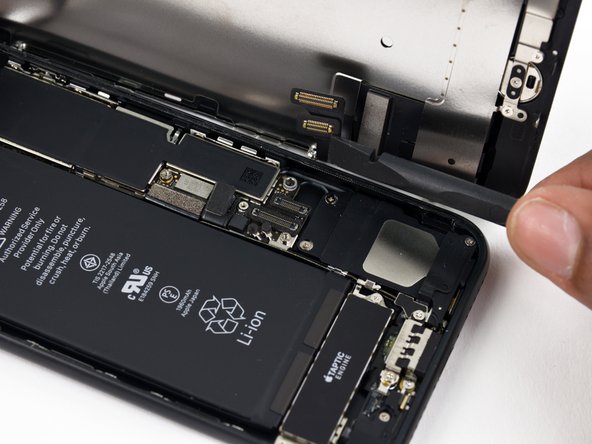
Use a spudger or a fingernail to disconnect the two lower display connectors by prying them straight up from their sockets on the logic board.
To reconnect these cables, press down on one end until it clicks into place, then repeat on the opposite end. Do not press down on the middle. If the connector is even slightly misaligned, the connector can bend, causing permanent damage.
If you have a blank screen, white lines on the display, or partial or complete lack of touch response after reassembling your phone, try disconnecting and carefully reconnecting both of these cables and make sure they are fully seated.

Disconnect the front panel sensor assembly connector from its socket on the logic board.
This press connector should also be reconnected one end at a time to minimize the risk of bending.
Step 6: Remove earpiece speaker
* If you bought the item with Spare Parts(Front Camera, Sensor Flex, Shield plate, Earpiece Speaker), no need to do this step.

Remove the three Phillips screws securing the earpiece bracket to the front panel:
Two 2.6 mm screws
One 1.7 mm screw


Remove the following two Phillips screws securing the earpiece speaker to the front panel:
One 1.9 mm screw
One 2.5 mm screw

Step 7: Remove front-facing camera and sensor cable
* If you bought the item with Spare Parts(Front Camera, Sensor Flex, Shield plate, Earpiece Speaker), no need to do this step.
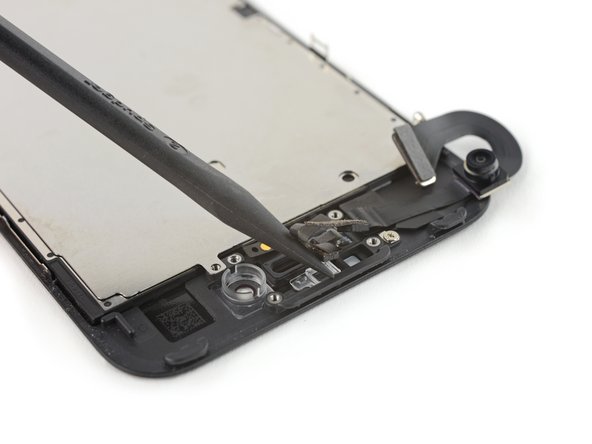
Use a spudger to gently pry the ambient light sensor out of its recess on the front panel.
Try to get your tool all the way under the sensor to pry it away from the clear plastic beneath. If you pry only against the cable, the sensor may separate from the cable assembly and will need replacement. If you're replacing the sensor/cable assembly anyway, then it doesn't matter.


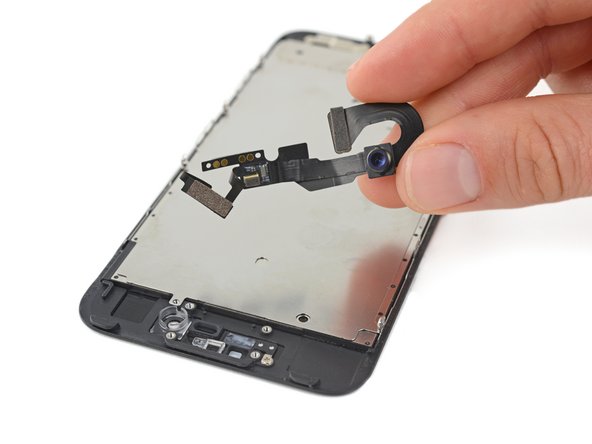
Step 8: Remove Home Button

Remove the four Y000 screws securing the bracket over the home/Touch ID sensor:
One 1.1 mm screw
Three 1.3 mm screws
During reassembly, be careful not to overtighten these screws, or your home button may not work.

Pry under the left edge of the home button cable connector to disconnect it from its socket.
If the entire connector begins to flip up without separating, press down on the cable at the top edge of the connector with the flat of your spudger, while simultaneously prying up the left edge of the connector. Be very careful not to damage the cable or connector, or you will permanently disable the sensor.

Carefully pry up the underlying connector and move it out of the way of the home/Touch ID cable.
It's very easy to damage your iPhone during this step. Work slowly and take care where you pry with your tool. If you damage the Touch ID hardware, it can only be replaced by Apple.
If the connector doesn't pry up easily, use a hair dryer or iOpener to heat and soften the adhesive securing the connector, and then try again.
Don't try to detach the connector completely—simply flip it up slightly so that the underlying home/Touch ID sensor cable can be removed.
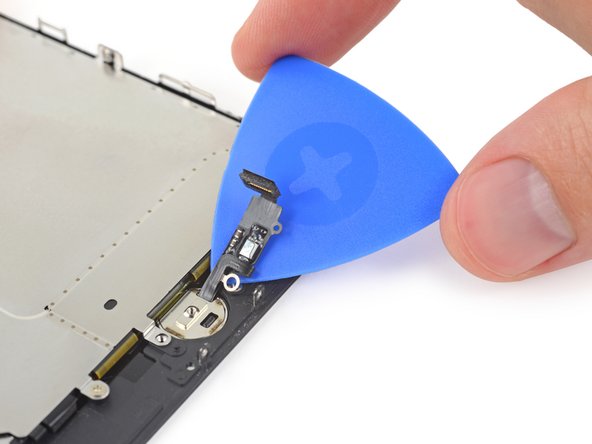
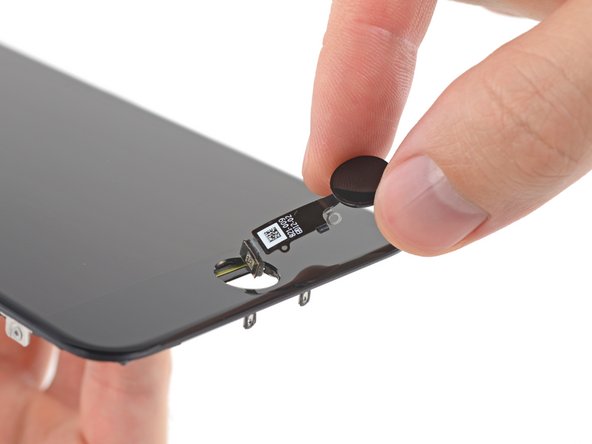
Remove the home/Touch ID sensor assembly by lifting it through the front side of the display.
To reinstall, first feed the cable through the hole in the front of the display.
Your replacement part may come with an extra Y000 screw already installed right of the Home Button. Remove the unnecessary screw so that you can reinstall the home button bracket.
Step 9: Remove the LCD shield plate
* If you bought the item with Spare Parts(Front Camera, Sensor Flex, Shield plate, Earpiece Speaker), no need to do this step.





Gently lift the LCD shield plate from the display assembly.
Be careful not to snag the display data cables when removing the LCD shield plate.

